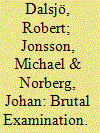|
|
|
Sort Order |
|
|
|
Items / Page
|
|
|
|
|
|
|
| Srl | Item |
| 1 |
ID:
184982


|
|
|
|
|
| Summary/Abstract |
Russian armed forces’ lacklustre performance in Ukraine has surprised military analysts. Shortcomings have included breakdowns in logistics, poor equipment and morale, abysmal communications, and muddled command and control, as well as a weak showing by the Russian Aerospace Forces, air defence, and cruise and ballistic missiles. Chief among the contributing factors are wishful political thinking, overreliance on esoteric doctrine and endemic corruption. War, however, brutally exposes peacetime cheating. Consequently, estimates of Russian military capabilities – in particular, for large-formation combined-arms operations, logistics, air defence and intangibles such as morale – need to be carefully reassessed. Earlier analyses of a Russia–NATO conflict appear to have overstated the challenge of defending Europe. Looking ahead, the conventional threat from Russia seems less daunting than previously thought, and the country faces a formidable task in repairing depleted capabilities. That said, President Vladimir Putin’s appetite for risk is greater than anticipated.
|
|
|
|
|
|
|
|
|
|
|
|
|
|
|
|
| 2 |
ID:
177842


|
|
|
|
|
| Summary/Abstract |
Military operations lie at the center of international relations theory and practice. Although security studies scholars have used campaign analysis to study military operations for decades, the method has not been formally defined or standardized, and there is little methodological guidance available for scholars interested in conducting or evaluating it. Campaign analysis is a method involving the use of a model and techniques for managing uncertainty to answer questions about military operations. The method comprises six steps: (1) question selection, (2) scenario development, (3) model construction, (4) value assignment, (5) sensitivity analysis, and (6) interpretation and presentation of results. The models that scholars develop to direct analysis are significant intellectual contributions in their own right, and can be adapted by other scholars and practitioners to guide additional analyses. Careful model construction can clarify, but does not obviate, the uncertainty of conflict. To manage uncertainty in parameter values, scholars can use the “input distribution approach” to propagate uncertainty in inputs through to a model's output. Replications and extensions of Wu Riqiang's 2020 analysis of Chinese nuclear survivability and Barry Posen's 1991 analysis of the North Atlantic Treaty Organization's prospects against the Warsaw Pact illustrate the six steps of campaign analysis, the value of transparent models and the input distribution approach, and the potential of campaign analysis to contribute to policy and theory.
|
|
|
|
|
|
|
|
|
|
|
|
|
|
|
|
|
|
|
|
|